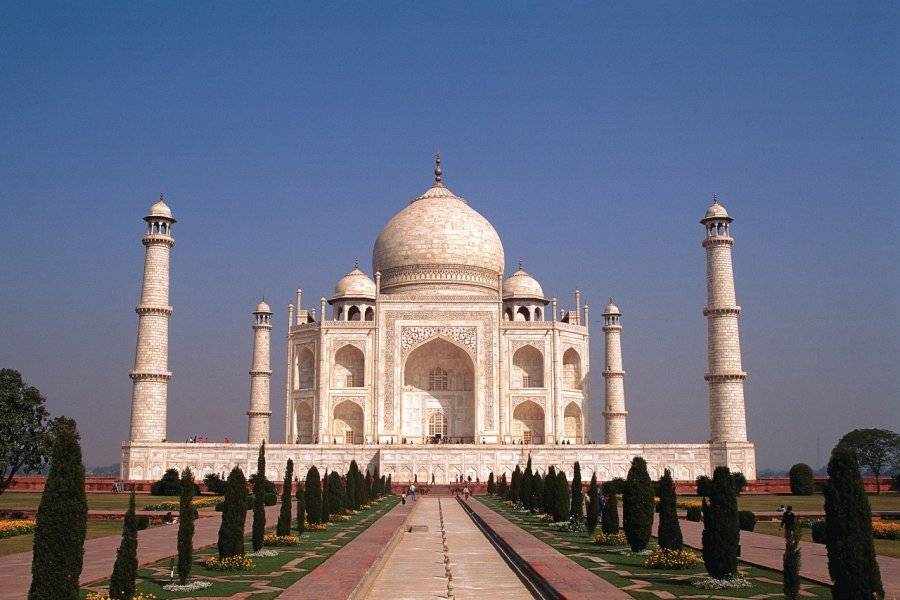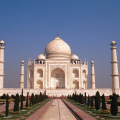TAJ MAHAL
An emblematic monument, one of the most famous in the world, with a typical Mughal garden, replica cenotaphs, a temple
A "tear on the face of eternity" is how the greatest Indian poet, Rabindranath Tagore described the Taj Mahal. This monument, emblematic of a country and one of the most famous in the world, is part of the world's architectural heritage as a testimony of eternal love, a romantic folly. The Taj Mahal is one of those monuments seen a thousand times in photos or in reports. And yet, when it stands in all its immaculate whiteness before your eyes, its beauty, its majesty, its grace operate. It is necessary to see it in the early morning hours, when the sun still asleep comes to caress the white marble of its first rays, adorning it with pearl reflections. This is also the time when the crowd is smaller and the place is yours. The height of romance, however, is to visit it on a full moon night. The moon makes it stand out from the navy blue sky, the gardens appearing in the half-light. Inspired by the Persian style, the gardens are laid out in an enclosed space and the canals and alleys draw rectilinear plans. The ponds are placed to reflect the gardens, the sky and here, the Taj Mahal. The paths divide the flowerbeds into 8 parts, an auspicious number for the Muslims. Each square has 16 beds of flowers. In the Koran, the garden is the symbol of paradise, and it is easy to understand why they have been particularly cared for here. For the Taj Mahal is a tomb. It houses the tomb of Mumtaz Mahal, for whom it was built, and that of Emperor Shah Jahan who ruled northern India from 1628 to 1658.
What is so moving about the Taj is that it is primarily a testimony of love from a man to his wife. In 1631, when Mumtaz was 39 years old, she died giving birth to her fourteenth child. On her deathbed, she enjoined her husband to show the world how much they loved each other. For two years, Shah Jahan mourned before deciding to give in to his other passion: architecture. He designed the Taj Mahal, the "crown of the palace", which he placed on the bank of the Yamuna, wishing to be able to contemplate it from the Agra Fort where he lived. Seventeen years of hard work, 22,000 men and 1,000 elephants were needed to build it. The marble was transported by elephant from Jodhpur, the jade was brought from China, the turquoise from Tibet, the agates from Yemen and the gold from Egypt. It is said that Shah Jahan intended to build an identical tomb for himself, but this time in black marble. Unfortunately, shortly after the construction of the Taj Mahal began, the emperor was overthrown by his own son, Aurangzeb, who had him imprisoned in the Agra Fort. It is thus through a window that he assisted for the remainder of his life to the progress of the work. Legend has it that Shah Jahan wanted to have the hands of all the craftsmen who worked on the site cut off, so that no replica could ever be built. When he died in 1666, he was nevertheless buried alongside his wife.
If the emperor participated so much in the conception of the building that he is said to be its architect, in reality there is some doubt... The building is said to have been designed by the master architect Ustad Ahmad Lahori. It rises to a height of 171 meters. The imposing dome, which measures 35 meters, is surmounted by an Islamic spire of 10 meters which was previously in gold.
Once youhave passed the security service's regulatory search, you find yourself at the foot of a huge red sandstone door inlaid with white marble. The splendor and majesty of this door foreshadows what awaits you behind it. It is often very crowded around the gate, as tourists rush to take a picture of the Taj Mahal and its gardens from the stairs. It is often necessary to play elbows and to wait a good moment before being able to make a photograph yourself. The garden, typically Mughal, is divided into four equal parts. In the center, a canal feeds a basin in which the Taj Mahal is reflected. And in each corner of the space, gardens planted with trees and a green lawn.
In the central canal is reflected the monument framed by four minarets purely decorative.
The minarets were built in such a way that, in case of an earthquake, they fall outwards and not on the dome of the Taj. The latter is framed by two symmetrical buildings. The one on the left, facing west, is an active mosque - especially on Fridays - but not the other one. To reach the mausoleum, you will have to take off your shoes: bare feet, you will feel better the cold marble!
Inside, you will discover the replicas of the cenotaphs of Mumtaz Mahal and Shah Jahan. The original tombs are in the basement. A guide will be sure to let you hear the extraordinary echo under the dome or shine his flashlight on the inlays of semi-precious stones in the marble. Respectful silence is normally requested.
Walk around the Taj and watch the differences in the color of the marble as the sun rises: pink in the morning, white during the day, and golden under the moon. Admire the inlays on the walls and around the porticos. Quranic verses have been inlaid in the marble. Take time to notice that all four sides of the building are strictly identical.
Behind the Taj, you will find the Yamuna, a small temple and women doing laundry.
Did you know? This review was written by our professional authors.
Members' reviews on TAJ MAHAL
The ratings and reviews below reflect the subjective opinions of members and not the opinion of The Little Witty.









